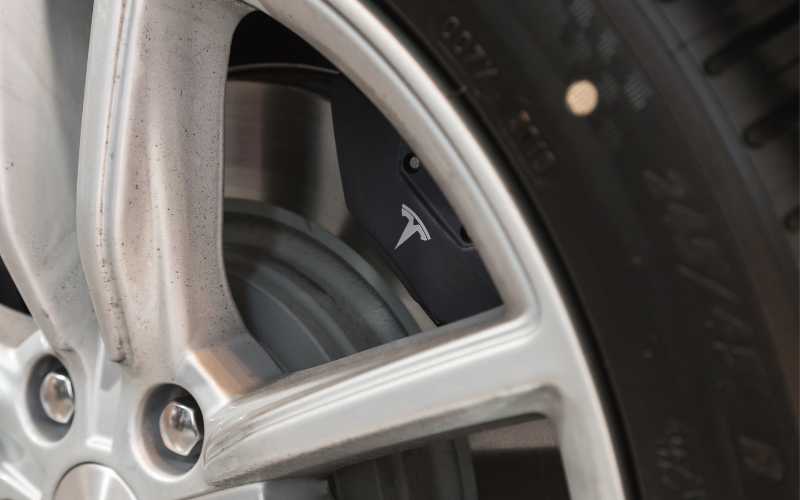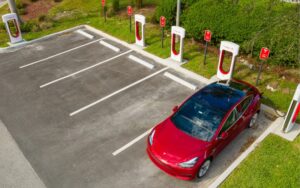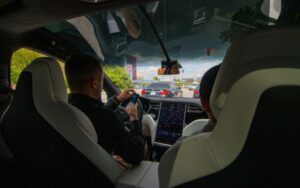Tesla Brake Pads (Purpose, Cost & More)
Last updated on September 12th, 2023 at 03:03 am
If you own a Tesla, you don’t worry much about the brakes.
It happens to be so because the Tesla models S, 3, X, and Y in performance, dual-motor, and single models barely use the brakes.
Most Tesla users question if the brake pads would never need replacement. Read on to find out.
Tesla brake pads are the functional friction factor of the brakes. They attribute this to applying the exact amount of friction and pressure on the brake rotor, slowing the wheel halts the Tesla. Tesla brake pads are usually made from semi-metals to synthesize ceramics and solidified organic materials. The pads will be fixed on a galvanized steel plate sealed with a caliper allowing easy replacement.
This article will explain the purpose, cost, and best Tesla brake pads and their care.
Also, we’ll discuss the replacement of Tesla brake pads, as that has to be the most controversial discussion amongst Tesla owners.
Do Tesla Cars Have Brake Pads?

Yes, most Tesla models have brake pads. Tesla brake pads are operative in creating friction by clasping the brake rotors.
By creating friction, they slow down the rotation of the Tesla wheels by creating heat with the forward velocity. This action will eventually stop Tesla.
Where the usual combustion vehicle uses brake pads every time it needs to stop, the Tesla will only use them rarely for a rough halt. So on most occasions, it could barely be in use.
The brake system is a crucial part of any of the Tesla models. A functional working brake system will help the driver improve the vehicle’s stop.
Ceramic and organic materials are common in making Tesla brake pads. As a result, they are long-lasting but more expensive than essential brake pads.
For Tesla Model A, semi-metal pads are advisable for rough haltings. In contrast, ceramic brake pads are suitable for sports cars.
Understanding the factors that go with your vehicle type and elements that go in line with the brake pads is critical.
How Much Does It Cost to Replace Brake Pads on Tesla?
Generally, Tesla brake pads cost around $250 to $400 per axle. It includes spare part repair and labor costs.
The replacement cost of Tesla brake pads solely depends on location, regional labor fees, and spare part costs.
If you’re looking to replace your Tesla brake parts, it’ll be best to search for repairs around you.
Replacing Tesla brake pads is rare because they are long-lasting and have regenerative braking. They don’t require a different friction pad.
It is so because there is no additional weight on the brakes, complications, or expenses.
However, brake pad replacement only covers auto repairs like resurfacing or rotor replacement, even though they come together with the brake pads.
Worn-out brake pads instantly affect your Tesla braking capacity.
Driving a Tesla with worn-out brake pads can be disastrous and lead to serious engine damage if not properly inspected.
Here are the common ways to identify defective, faulty brake pads:
#1. Odd Sensation when Hitting the Brakes
When you’re about the brake and steer your Tesla, which usually feels shaky or loose, there may be irregular brake pad wear.
Sometimes, the brake pedals may feel weak. The shakiness is a result of problems with the brake fluid.
#2. Unusual Noise in the Brake System
Hearing unnecessary and unusual sounds like low metal friction, load squeaking, and excessive squealings? Then your brake pads are worn out.
#3. Brake Pads Rise in Temperature
Unlike most vehicles, Tesla doesn’t have a brake pad wear sensor.
The brake pads and rotor temperature sensor rise between 200 to 400 degrees Fahrenheit, reducing the brake fluid level of the brake system.
#4. Noticeable Worn-Out Signs
Tesla brake pads rarely wear out due to the composite material it’s made of.
But when it does, there are obvious signs that will need inspections.
By recognizing these signs in defective brake pads, you can hire an expert EV repairer or repair auto service by performing the following;
- Verify the density and durability of the brake pad gear. Doing so can provide temporary replacements if the density measures are less than 2 mm. You’ll need to purchase a pair of vernier calipers to measure the brake pads.
- Confirm that the brake system parts, like the caliper sliding pins, are properly greased.
- Conduct drive trials to test your Tesla to know how efficient the brakes are.
- Ensure the brake fluids are at their correct measurement always.
- Carefully Inspect the brake rotor using specialized tools to estimate the discrepancies, warpage, density, and other differences.
- Search for clasped calipers by checking the calipers, galvanized steel plate rotors, and pads.
According to Tesla CEO Elon Musk, the brake pads on Tesla never need to be replaced. But, unfortunately, it is only partially true for a substantial; Teslaer of Tesla drivers.
Experienced Tesla drivers recommend users inspect, flush and change the brake fluids yearly. Yearly checks ensure the effective functioning of the brake and brake pads.
What Are the Best Brake Pads for Teslas?
The brake pads are a neglected yet important part of the Tesla vehicle.
Yet, they play a vital role in the safety of driving, whether fast or slow.
When rating with EV engineers, you’ll often hear terms like organic, hybrid ceramic, and semi-metallic brake pads.
You’ll hear these terms because they are the materials of which the brake pads and up.
Brake pads come in different types with different purposes, varying in composition, performance, quality, and price.
Organic brake pads are the most preferred by many Tesla owners as they are more malleable than semi-metallic or ceramic brake pads.
By being malleable, they maintain outstanding brake executions under harsh braking circumstances. Also, they come at pocket-friendly prices.
Organic brake pads are an excellent choice for most Tesla drivers.
However, a few Tesla drivers may beg to differ, as organic brake pads have their cons.
The table below shows the pros and cons of organic brake pads on Tesla.
| Pros | Cons |
|---|---|
| Less likely to make squeaky noises | They are likely to stick to the wheels. |
| Durable for the braking system of a Tesla | Little execution capacity |
| Very rotor-friendly | It has a less pedal feel. |
| They are very affordable. | They wear out quickly. |
Best Practices for Maintaining Tesla Brake Pads
Like gasoline cars, preventive measures taken to maintain the Tesla brake pads are no different.
Unlike non-electrical vehicles, Tesla doesn’t require emission checks or oil changes.
Replacing brake pads is unusual because of the regenerative feature of the braking system.
This braking feature allows the energy in Tesla’s battery to curtail the wear and tear of the brakes.
To maintain your Tesla braking pads, it is advisable to check your brake fluid for impurities yearly and replace it when due.
Also, clean out and lubricate the brake calipers yearly, especially if you live in very cold regions.
FAQs
Do Teslas Use Brake Fluid?
Yes, Teslas use brake fluids for the brake system. Most Tesla models use the DOT 3 brake fluid.
How Does a Tesla Brake System Work?
Tesla Model S has a brake system that hinders the application of extreme pressure on the tires from latching. The brake system is known as the anti-lock braking system (ABS).
How Long Do Brake Pads Last on Tesla?
Tesla brake pads can last for years, depending on how long you drive and the road conditions. However, it may take 3-5 years to replace brake pads on Tesla.

Hey, I’m Michael Davis, a 35-year-old with a degree and a love for cars and tech. Since I was a kid, cars have been my thing—so much that I even thought they ran on magic beans! Fast forward, and I’ve built Vehicle Army, your one-stop-shop for easy-to-understand car facts.






